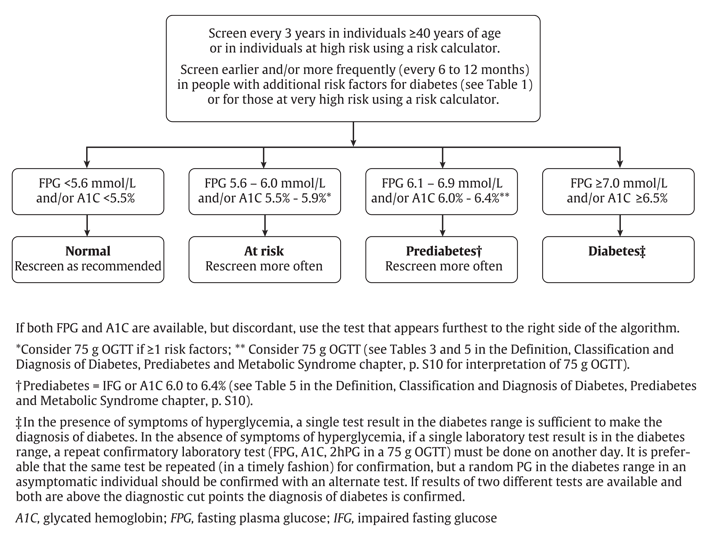Diabetes Mellitus
Diagnosis of Diabetes
Jennifer Kong
Learning Objectives
By the end of this section, you will be able to:
- Briefly describe some of the laboratory tests of diagnosing diabetes mellitus
- Random blood glucose test = blood is taken at any time of the day, regardless of whether the patient has eaten/drunk recently
- Fasting blood glucose test = blood is taken when patient has not eaten/drunk for at least 8 hours prior. In healthy fasting patients, there should be normal glucose levels with low insulin.
- Oral glucose tolerance test = patient is given a known amount of sugar to drink and then waits for 2h before blood sample is taken for glucose levels. In a non-diabetic patient, insulin should be released to lower blood sugar levels down to normal. In a diabetic patient, blood glucose levels will be high.
- Ketone test in blood or urine = the presence of ketones in the blood (draw blood) or urine (urine sample in obtained in a cup) suggests that tissues are not using glucose for energy, possibly because insulin isn’t available.
- Hemoglobin A1C = this blood test examines the presence of high blood sugar in the body for more than 3 months. Since red blood cells live for less than 4 months, those red blood cells accumulate the excess sugar that it is exposed to during those months. Specifically, the hemoglobin molecule will pick up sugars in a process called glycosylation. The hemoglobin will be more glycosylated only if there is excessive sugar exposed to the hemoglobin in the 3-4 months of the RBC life.
|
Diagnosis of Diabetes Meeting ANY of the following criteria confirms diagnosis when classic symptoms of hyperglycemia are present Absence of classic symptoms of hyperglycemia requires a repeat confirmatory test |
|
| FPG ≥7.0 mmol/L |
|
| A1C ≥6.5% (in adults) |
|
| 2hPG in a 75 g OGTT ≥11.1 mmol/L | |
| Random PG ≥11.1 mmol/L in a patient with classic symptoms of hyperglycemia |
|

Section Summary
Diabetes is diagnosed through a blood test measuring glucose levels. Throughout the day, blood glucose levels fluctuate depending on meals and activity: blood glucose levels should be between 4-11 mmol/L. Hence, patients are instructed to not take in any nutrients (i.e. fast) for >8h to ensure – presumably – low levels of insulin with a normal range of blood glucose. If a patient’s fasting plasma glucose is above normal range (i.e. hyperglycemia), this indicates a lack of insulin response: whether due to lack of circulating insulin (T1DM) or resistance to insulin at the the tissue level (i.e. T2DM or gestational). If hyperglycemia is present for more than 3 months, the excess sugar will modify the red blood cells that can be detected by measuring glycosylated hemoglobin – known as “Hemoglobin A1C”. A further test for suspected diabetes is the oral glucose tolerance test (OGTT) where the patient ingests a known amount of sugar orally and their blood is measured 2h later when, presumably, insulin levels will be at their highest with a decrease of blood sugar as the tissues respond to insulin. As hyperglycemic blood is being filtered by the kidney to produce urine, urine can be examined for the presence of glucose and/or ketones. Ketones will be present in both blood and urine if an abnormal amount of fat metabolism is occurring to compensate for the lack of glucose entering tissue for metabolism. When more than one test measures an inappropriately high amount of blood sugar/presence of ketones, diabetes mellitus is suspected and further investigations is needed to differentiate between the types of diabetes mellitus.
Review Questions
Media Attributions
Diabetes Canada Clinical Practice Guidelines Expert Committee. Diabetes Canada 2018 Clinical Practice Guidelines for the Prevention and Management of Diabetes in Canada. Can J Diabetes. 2018;42(Suppl 1):S1-S325. [Internet]. [cited 2020 Oct 16]. Available from: http://guidelines.diabetes.ca/cpg
BC Guidelines for Diabetes Care https://www2.gov.bc.ca/gov/content/health/practitioner-professional-resources/bc-guidelines/diabetes#3

